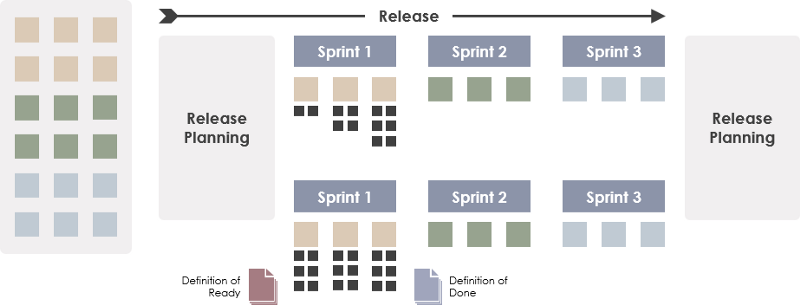End users sometimes have ideas or concepts for new features. The concept is represented as one or more function items and added to the product backlog by the product owner. The team will work together to find out how to translate this concept into one or more epics, and then refine it into smaller and clearer user stories, which will be incorporated into the next sprint implementation as a real product function.
However, ensuring that user stories are ready before the sprint can have a direct and significant impact on team productivity. Having a definition of “ready” means that the story must be immediately ready for implementation. The team must be able to determine what needs to be done and the amount of work required to complete the user story
The team will pull the stories at the top of the product backlog into the sprint backlog. These stories must be “ready”. Some companies actually need a detailed list to determine whether a story is “ready”, not just “almost” .
How to Create the Definition of Ready?
The product owner could work together with the team to define an artifact called “the definition of Ready” for ensuring that items at the top of the backlog are ready to be moved into a sprint so that the development team can confidently commit and complete them by the end of a sprint.

Why Definition of Ready?
The Definition of Ready is a set of agreements that lets everyone know when something is ready to begin, e.g., when a user story is ready to be taken into a sprint, or when all necessary conditions are right for a team to start a sprint. An appropriate definition of ready will substantially improve the Scrum team’s chance of successfully meeting its sprint goal. Here is a list of benefits that a properly structured DoR can bring to teams:
- Measure a backlog item’s “ready” state
- Ensure that product backlog items have been thought through “just enough”
- Help the team identify when the product owner or another team member becomes overwhelmed
- Keep the team accountable to each other
- Reduce pressure on the team to commit to estimates before stories are “Ready”
- Reduce “requirements churn” in development
Example — Definition of Ready for a Sprint
Different teams will have different Dentition of Ready, and some require less. i.e., some teams just describe the value to the user, prioritize, and write how to demo. Other estimates and communication are in the sprint planning meeting and etc. Here is the sample items to be considered for developing DORs for your team:
- The Sprint Backlog is prioritized
- The Spring Backlog contains all defects, User Stories and other work that the team is committing to
- No hidden work
- All team members have calculated their capacity for the Sprint
- Fulltime on project = X hours per day
- All User Stories meet Definition of Ready
Example — Definition of Ready for a User Story
This section shows a sample Definition of Ready for a user story, and a sample Definition of Ready for a Sprint. You can adopt some of these as baselines or starting points:
- The value of Story to the user is clearly indicated.
- The acceptance criteria for Story have been clearly described.
- User Story dependencies identified
- User Story sized by Delivery Team
- Scrum Team accepts User Experience artifacts
- Performance criteria identified, where appropriate
- Person who will accept the User Story is identified
- The team knows how to demo the story.
Summary
The term “definition of ready” is not described in the scrum guide. It is the same as the user story and acceptance criteria embedded in it. Perhaps you might think that the definition of ready is an integral part of the product backlog refinement activity, rather than using the definition of ready as a sequence and stage gate checklist. Backlog refinement is an ongoing process, so it is not limited to an event, but regarded as an activity.





